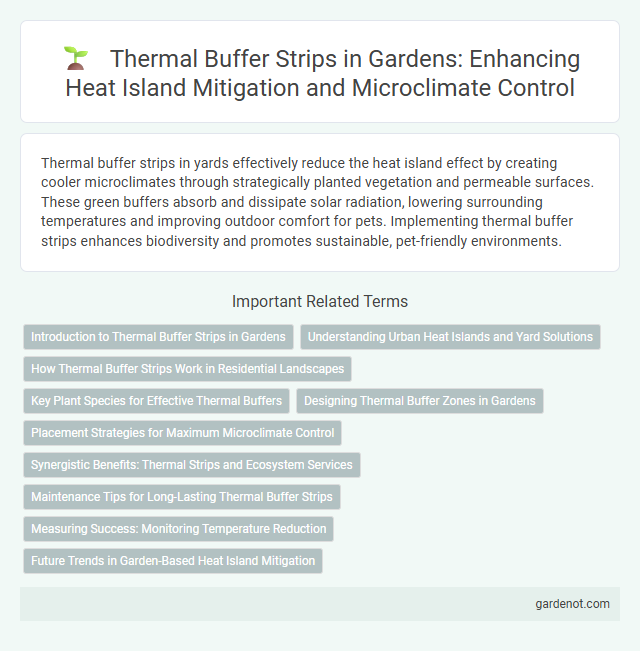Thermal buffer strips in yards effectively reduce the heat island effect by creating cooler microclimates through strategically planted vegetation and permeable surfaces. These green buffers absorb and dissipate solar radiation, lowering surrounding temperatures and improving outdoor comfort for pets. Implementing thermal buffer strips enhances biodiversity and promotes sustainable, pet-friendly environments.
Introduction to Thermal Buffer Strips in Gardens
Thermal buffer strips in gardens play a crucial role in mitigating urban heat island effects by providing shaded areas and cooling through evapotranspiration. These strips, often composed of dense vegetation such as trees, shrubs, and ground covers, reduce surface temperatures and improve microclimatic conditions in residential and urban yards. Integrating thermal buffer strips strategically enhances outdoor comfort and supports energy savings by lowering ambient temperatures.
Understanding Urban Heat Islands and Yard Solutions
Thermal buffer strips are vital components in mitigating urban heat islands by reducing heat absorption and promoting localized cooling in yards. These strips, composed of vegetation or reflective materials, effectively lower surface temperatures by providing shade and enhancing evapotranspiration. Implementing thermal buffer strips in urban landscapes reduces ambient temperature, improves air quality, and contributes to sustainable urban heat island management.
How Thermal Buffer Strips Work in Residential Landscapes
Thermal buffer strips in residential landscapes function by creating shaded zones that reduce surface and air temperatures, effectively mitigating urban heat island effects. These strips, often composed of dense vegetation or permeable materials, absorb and dissipate heat while enhancing evapotranspiration. Their strategic placement around homes and yards moderates microclimates, lowers cooling energy demand, and improves outdoor comfort.
Key Plant Species for Effective Thermal Buffers
Key plant species for effective thermal buffer strips in heat island mitigation include native grasses such as Big Bluestem (Andropogon gerardii) and Switchgrass (Panicum virgatum), which provide dense ground cover and reduce surface temperatures through evapotranspiration. Fast-growing trees like Red Maple (Acer rubrum) and Eastern White Pine (Pinus strobus) create shaded microclimates that lower ambient heat and improve air quality. Integrating diverse shrub species such as Summersweet (Clethra alnifolia) enhances the thermal buffering capacity by disrupting wind flow and promoting cooler under-canopy conditions.
Designing Thermal Buffer Zones in Gardens
Designing thermal buffer zones in gardens involves incorporating dense vegetation and reflective surfaces to reduce heat absorption and promote natural cooling. Strategically placed trees and shrubs create shaded areas that lower surrounding air temperatures by blocking solar radiation and enhancing evapotranspiration. Utilizing thermal buffer strips with native plants supports microclimate regulation, contributing to effective urban heat island mitigation and improved outdoor comfort.
Placement Strategies for Maximum Microclimate Control
Thermal buffer strips strategically placed along building facades and parking areas significantly reduce heat island effects by shading surfaces and enhancing evapotranspiration. Integrating native, drought-resistant vegetation in these buffer zones maximizes cooling benefits while minimizing irrigation needs. Optimal strip width and orientation aligned with prevailing wind patterns further amplify microclimate regulation, lowering ambient temperatures in urban yards effectively.
Synergistic Benefits: Thermal Strips and Ecosystem Services
Thermal buffer strips reduce urban heat island effects by shading surfaces and promoting evapotranspiration, lowering ambient temperatures. These vegetated strips enhance ecosystem services such as habitat provision, stormwater management, and air quality improvement. The synergy between temperature regulation and ecological functions optimizes urban microclimates and supports biodiversity resilience.
Maintenance Tips for Long-Lasting Thermal Buffer Strips
Regularly inspect thermal buffer strips for debris accumulation and promptly remove leaves, dirt, and other materials that could impede airflow and reduce cooling efficiency. Implement routine watering schedules to maintain vegetation health, as well-hydrated plants enhance shading and thermal regulation in heat island mitigation yards. Apply mulch around buffer strip plants to retain soil moisture, suppress weeds, and support long-term thermal performance.
Measuring Success: Monitoring Temperature Reduction
Thermal buffer strips significantly reduce urban heat island effects by lowering surrounding air temperatures through increased vegetation and shading. Monitoring temperature reduction involves deploying infrared thermometers and data loggers at multiple points within and around the strip to capture real-time thermal data. Analysis of temperature gradients over time confirms the strip's effectiveness in mitigating heat build-up, guiding future urban planning and landscaping efforts.
Future Trends in Garden-Based Heat Island Mitigation
Thermal buffer strips are emerging as a crucial element in future garden-based heat island mitigation, leveraging native vegetation to reduce surface temperatures and enhance microclimate regulation. Incorporating drought-resistant and high-transpiration plants within these strips optimizes cooling effects and water efficiency, aligning with sustainable urban landscaping trends. Advanced soil amendments and smart irrigation systems further enhance thermal buffering capacity, supporting resilient green infrastructure against escalating urban heat challenges.
Thermal buffer strip Infographic

 gardenot.com
gardenot.com